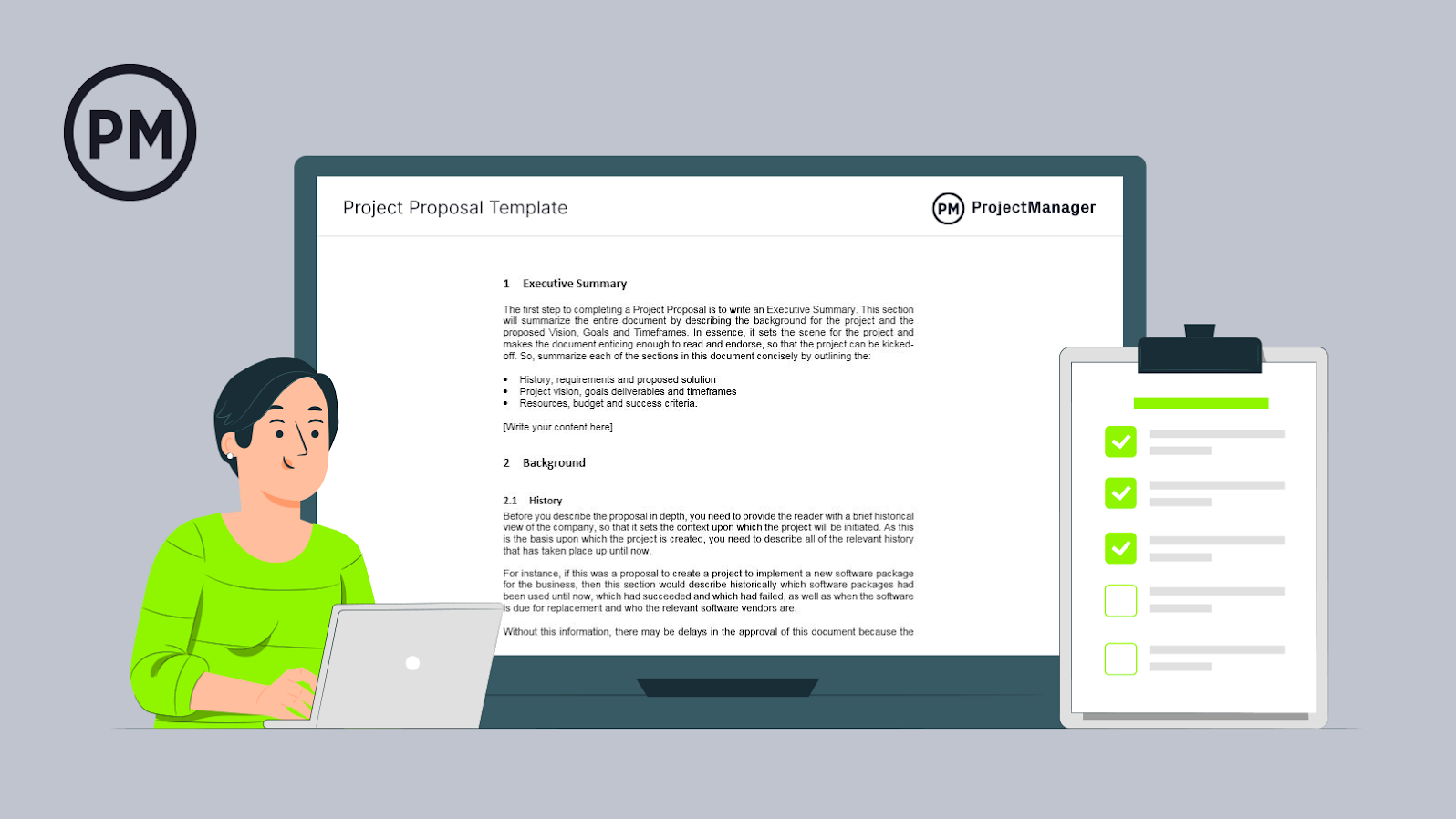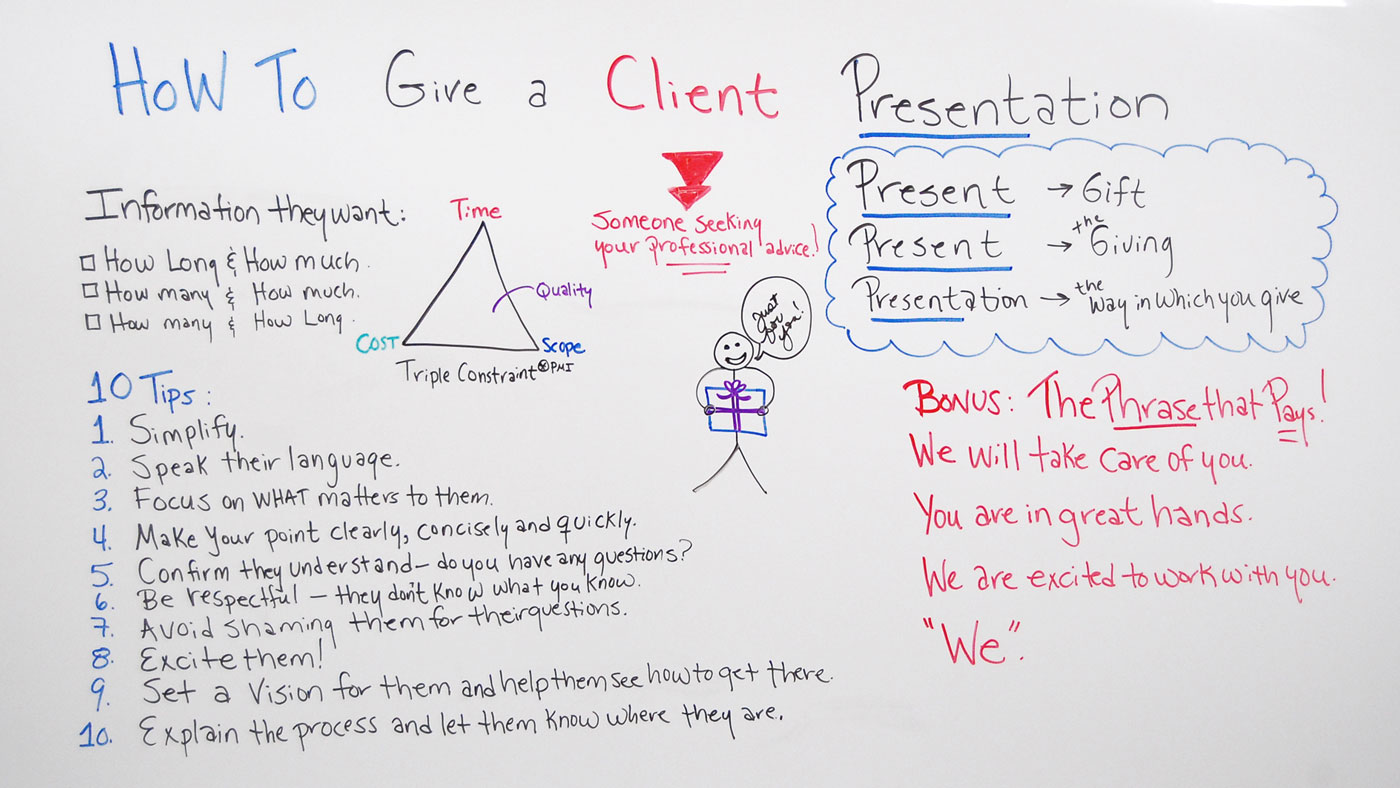Think of the word “present-ing” and consider your clients: they want you, the expert, to provide them with the information they want and need. If you think of your presentation as if you’re giving them a “present” (literally, your expertise), you can re-frame the meeting in a way that fills you with the confidence you need to communicate effectively.
What Is a Client Presentation?
A client presentation allows you to explain the importance of your work in a compelling way. It’s key for articulating your value, if it’s in the proposal stage, or your progress if you’re in the middle of a project.
Of course, you may give a wrap-up client presentation as well, where you’ll want to review what went well and what went wrong for your project.
Related: Ultimate Guide to Project Status Reports
Why Is a Client Presentation Important?
A client presentation is all about communicating. You’re the expert, and your job is to convey to your client everything that’s important. There is a lot of information that you have that your client doesn’t have. They’re not as well-versed in the project as you are. So, give them the gift of communication.
This is key for them to understand everything that went into the project. If your client presentation doesn’t effectively communicate, it’s failed.

Get your free
Project Proposal Template
Use this free Project Proposal Template for Word to manage your projects better.
Client Presentation Video
In this leadership training video, Jennifer Bridges, discusses the art and skill of communicating during client presentations.
How to Deliver a Client Presentation
- Simplify, simplify, simplify: A good client presentation always emphasizes clarity and simplicity. If your client doesn’t understand your presentation, then you’ve wasted your time.
- Speak their language: The best way to communicate effectively is to consider your audience. Don’t get caught up in jargon they might not understand. Speak plainly and honestly.
- Focus on what matters to them: Remember the goals of the project to begin with. Stay focused on what matters and don’t get lost in the details.
- Make your point clearly, concisely and quickly: People tend to have short attention spans. The sooner you can convey your meaning, the likelier it is that they will be able to process it and ask questions afterwards.
- Confirm they understand, and remember to ask questions: Don’t just assume they understand your points in your client presentation. It’s key to check in with them and be proactive by asking questions at the tail end of your presentation, or even the halfway point.
- Be respectful: Be respectful and be patient. These are your business partners. You don’t want to sour any relationships by how you respond to their reaction to your client presentation.
- Avoid shaming their questions: They don’t know what you know! Not everyone understands things quickly. That’s ok. It’s your job to make sure that your client presentation gets them to a place of understanding. Sometimes that doesn’t happen right away: keep at it.
- Excite them: Be enthusiastic about the project! People don’t respond to cold facts by themselves. Supercharge your client presentation with emotion and enthusiasm. But always stay professional.
- Set a vision for them and help them see how to get there: Be the expert and the visionary. You can’t do everything for them, but you can lay out a roadmap for them to reach their goals.
- Explain the process and let them know where they are: It’s key to be honest here. Sugarcoating reality isn’t going to help anyway, but try to pepper in good news with any bad news. Clients can be sensitive, but you’ll still need a good relationship to get anything done.
If you apply these simple tips to your presentations they will become not only more productive, but you’ll find that people will be eager to attend and engage and, most importantly, leave with a feeling of success.
Pro tip: Another tip when leading a presentation is the use of the royal “we”—not in an elitist way, but in such a fashion that you include yourself and everyone in the room in the discussion. This is a team effort, and even clients are part of the team!
Here’s a shot of the whiteboard from the video for your reference!

Transcription
Today we’re talking about how to give a client presentation. I’m not sure why we get so nervous about this. I mean think about it. If you have a present, aren’t you excited to give it to other person? So a reminder I have for myself is I think of literally giving my client of gift. Also, think of if you present something, that’s the giving of something and the presentation is the way in which you give. So when we’re giving something, a presentation to our client, well, they’re seeking your professional advice.
So let’s look at the information they want. So when we give a client presentation, they really wanna know how long is something going to take and how much is it going to cost. They also want to know how many is going to be produced and how much they’re going to cost. They may want to know how many and how long is it going to take. Basically, they’re talking about items of the Triple Constraint as identified by PMI. It’s the time, the cost, the scope, and the quality.
So there are 10 tips that we found that are really helpful in giving a client presentation.
First of all, simplify what you give them. Right? Don’t overwhelm them, make it simple. Speak their language, something they can understand and relate to their world. Focus on what matters to them. Make your point clearly, concisely, and quickly. I mean they do not want to be there all day, like taking forever. They want you to get to the point. Get them to point A to point B quickly.
Confirm they understand what you’re talking about and stop and ask. Do you have any questions? Is this what you expected? Is this helpful? So give them pause and give them time to think about it, to make sure they follow you, and give them an opportunity to ask questions. We also want to be respectful. I mean, after all, they’re the client so they don’t know what you know. So we want to be respectful if they have questions and they may not get it yet. We also want to avoid shaming them for their questions. I mean they may have questions that for you are immature, but they don’t know.
So it’s important to give them the space and honor what they’re asking. Excite them, get them excited about what you’re presenting, something about their project, or their status or where they’re going or what they can obtain from this. And also it helps to set a vision for them and help them see how to get there. If you set a vision and they can’t even conceptualize how in the world we’re going to pull that off then they’re going to be left dazed and confused or they’re not gonna believe that it’s possible. And you also want to explain the process and let them know where they are in the process of the project.
So again there are some bonus phrases that we feel like we call “The Phrase that Pays.” Number one let them know and tell them we will take care of you. That’s really comforting to know. You are in great hands. Let them know that you and your team are there in great hands. And also let them know we are excited to work with you. That really gets people to know that you’re engaged and use the phrase, “We.” If you need help presenting to your client, then sign up for our software now at ProjectManager.
Related Client Management Content
- Client Management: How to Win and Retain Clients
- How to Write a Client Brief (Example & Template Included)
- The Importance of Customer Development for Startups
- Free Service Report Template for Word
- Free Client Intake Form for Word
- Ways Project Managers Can Help with Customer Engagement
- Ways to Collect Better Customer Feedback

